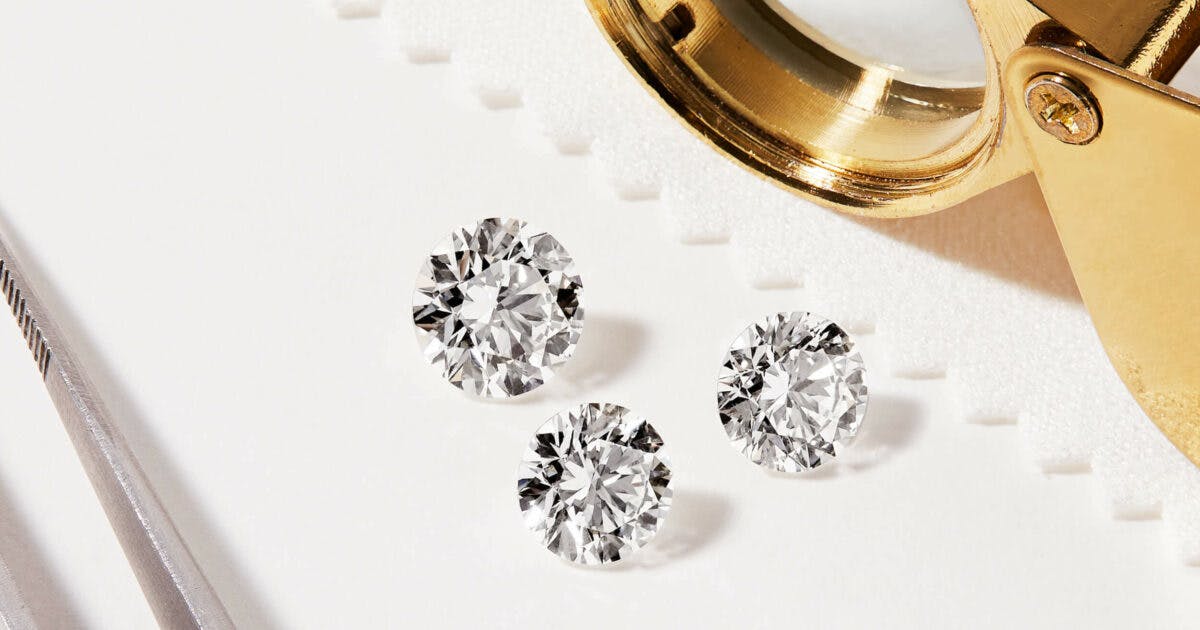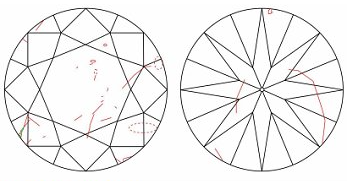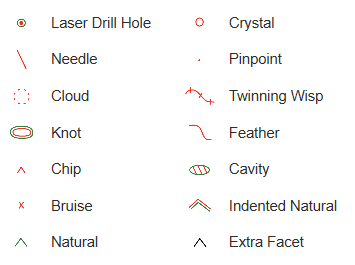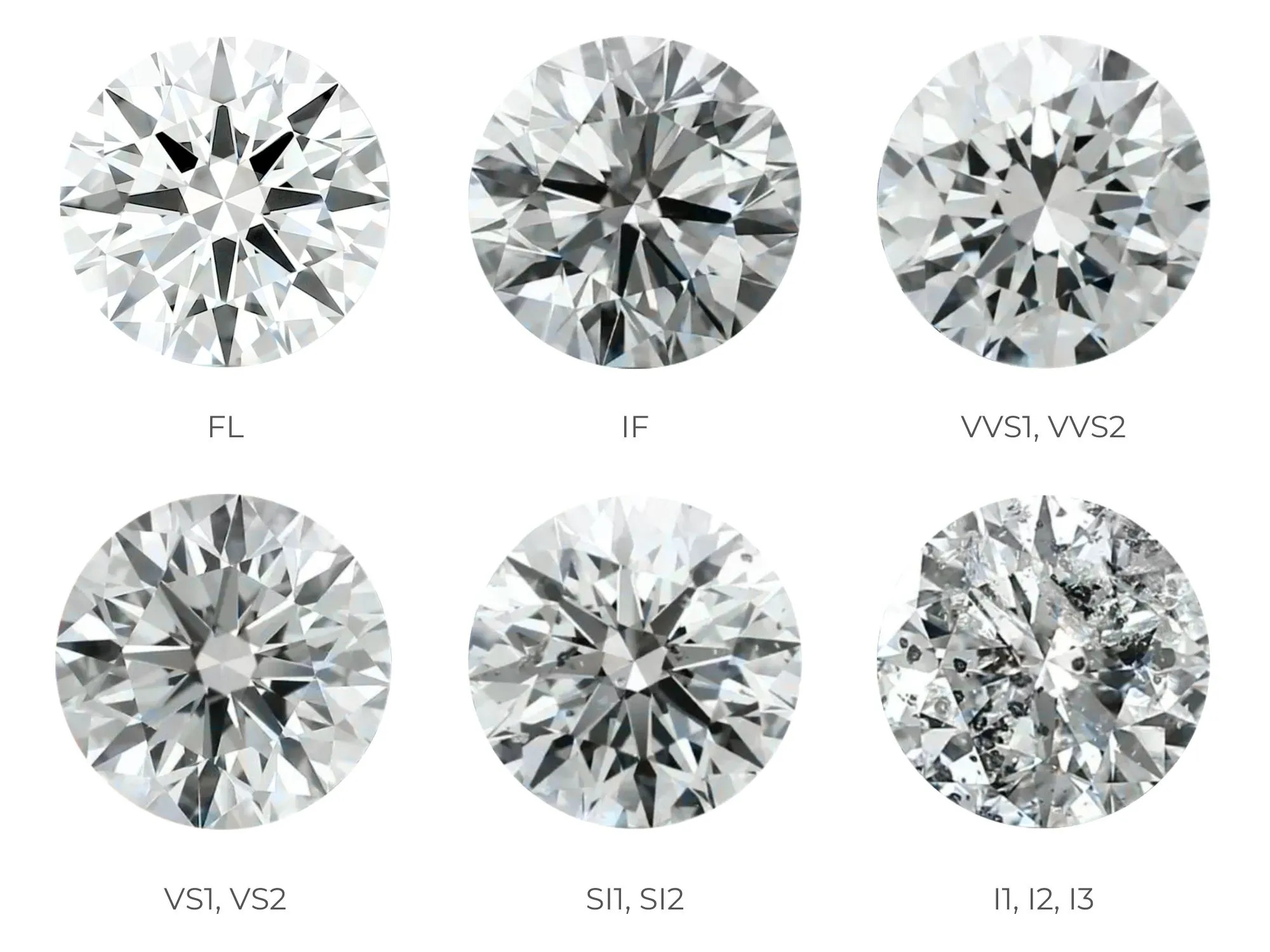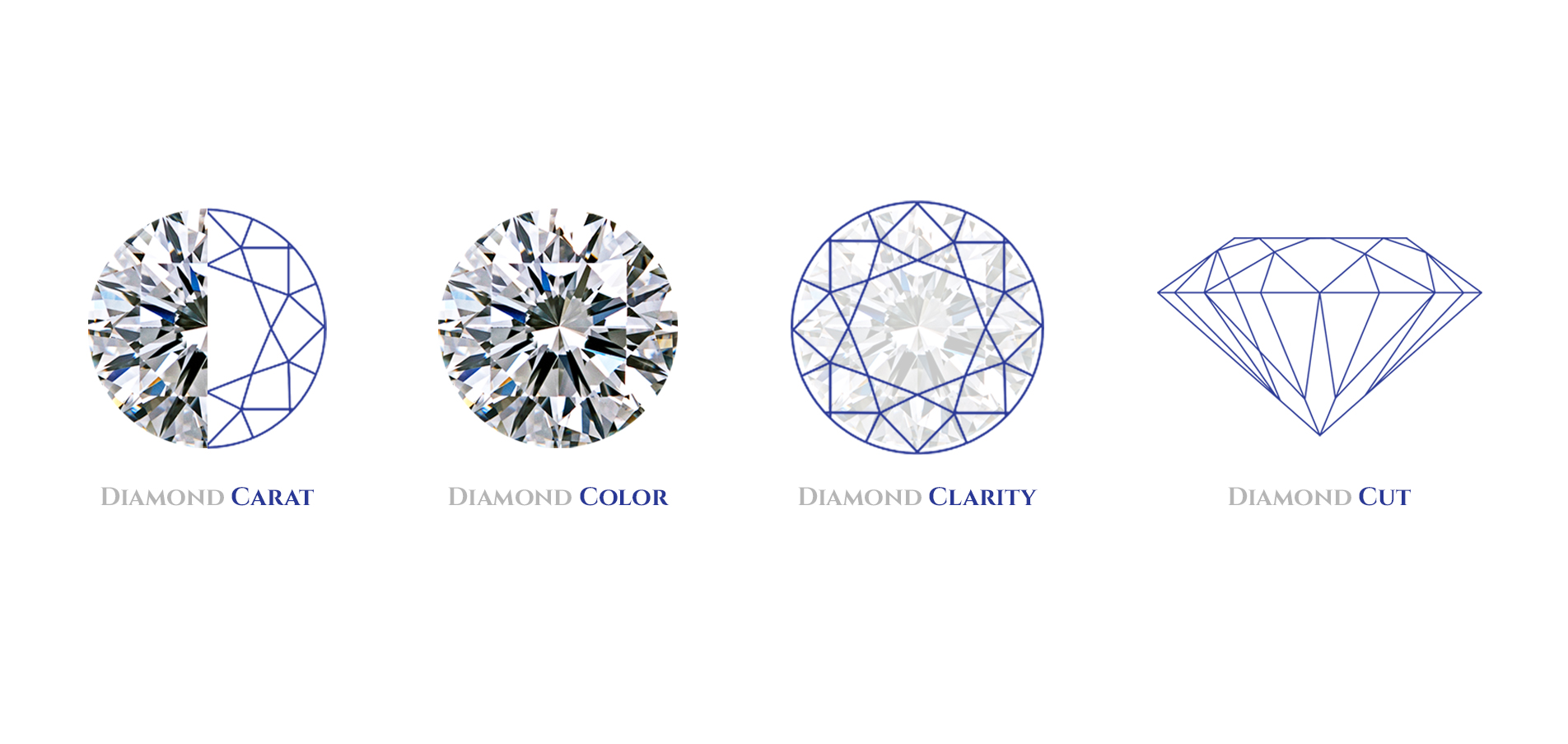Diamonds are a timeless symbol of beauty and luxury, so it’s only natural for us to want to understand them better. With the diamond clarity chart, we can do just that. The chart gives us the ability to examine different qualities of diamonds including their construction and clarity. By exploring these secrets we can gain a deeper understanding of how diamonds work and how they differ in quality. The article talks about Diamond Clarity Chart in detail, differences between Clarity and Cuts, differences between Clarity and color, how the customers can read the chart before buying the Diamonds.
What is a Diamond Clarity Chart?
A diamond clarity chart is an important tool for anyone looking to purchase a diamond. It can help you make sure that you are getting the best quality diamond for your money. Clarity Chart will help you identify the flaws or inclusions that might be present in the stone. This will assist you to make critical decision in buying expensive diamonds.
Diamonds have been coveted and cherished for centuries, making them one of the most sought after gems on earth. They come in many shapes and sizes. Beauty is that all diamonds are unique and beautiful in their own way. It is very important to find out as much about each stone before you buy it. With a clarity chart at hand, you can easily distinguish between stones of varying degrees of quality. By understanding what makes one diamond better than another, you can ensure that your purchase is truly worth its value.
Factors Affecting Clarity
When it comes to diamonds, clarity is a key factor in determining the beauty and worth of the diamond. Clarity on diamonds is graded on a scale from flawless (FL) to included (I3). The higher grade of clarity, the more valuable and beautiful the diamond.
The factors that affect clarity include blemishes, flaws and inclusions. Inclusions are internal features such as air bubbles or mineral deposits that can have an impact on light performance within a diamond. Blemishes are external features like nicks or abrasions that occur when a stone is cut or polished too roughly. While these imperfections can be seen with the naked eye, some may require magnification for proper inspection.
Grading System
When it comes to buying the best quality diamond, you want to know exactly what you’re getting for your hard-earned money. The good news is that the diamond industry has a grading system in place to help you make an informed decision. With the diamond grading chart, you can compare diamonds side-by-side and determine which one fits your needs.
The chart outlines all of the important characteristics of a diamond and breaks down each grade into its corresponding clarity, color, cut and carat weight categories. Most diamonds are graded on a scale ranging from D (the highest grade) to Z (the lowest). This helps ensure that buyers get the most out of their purchase without compromising on quality or value.
Inclusions and Blemishes
When shopping for a diamond, it’s important to understand the differences between inclusions and blemishes. Inclusions are internal features that form in a diamond during its growth period, while blemishes are external or surface-level imperfections. Together, they provide an indication of the diamond’s clarity and quality.
It’s impossible to find a perfect diamond because these natural impurities emerge during their formation process. The degree of inclusions and blemishes will vary from stone to stone; some diamonds may have more visible marks than others. A true connoisseur knows that each unique combination of inclusions and blemishes can make a particular diamond visually stunning!
Diamond Clarity Scale Explained
Diamonds are the gemstone of choice for many occasions, from engagements to anniversaries. But, when it comes to the quality of a diamond, what does one need to know? The answer lies in understanding the diamond clarity scale. Every diamond has unique characteristics that affect its value – and how it looks to the untrained eye.
The most widely used diamond clarity scale is set by The International Gemological Institute (IGI). It classifies diamonds according to their inclusions or flaws as seen under 10x magnification. This includes everything from blemishes on the surface of a stone such as scratches, chips and cracks; to internal features such as feathers and clouds; all the way up to extraordinary features like crystal and needles.
The Importance of Diamond Clarity
Diamonds are a symbol of love, luxury and beauty. They have been coveted for centuries as tokens of appreciation and adornment. But not all diamonds are created equal. The clarity of a diamond is an important factor to consider when selecting the perfect ring, necklace or pair of earrings.
Clarity refers to the amount of inclusions within the diamond itself that can be seen with a microscope or loupe – gemologists use a clarity chart ranging from Flawless (no inclusions) to Included (many imperfections). Each grade has its own unique characteristics that determine how beautiful and valuable it is. The higher the grade, the more expensive it will be – but also, the more brilliant it will look due to its lack of inclusions.
How Gemologist Grade the Quality
Gemologists have a very difficult task when it comes to grading the clarity of diamonds. It is an incredibly precise job that requires intense focus and knowledge. Being able to accurately grade the clarity of a diamond is essential for jewelers, collectors and investors alike, as it can be the difference between making a great purchase or not.
The process of determining the clarity in diamonds starts with gemologists using magnifying loupes to inspect each stone closely. Every mark, inclusion or blemish has to be carefully evaluated in order to determine its effect on the beauty of the diamond – this is known as its “clarity grade”. Gemologists will then use their expertise to assign each diamond an appropriate grade from FL (flawless) all the way down to I3 (included 3).
4Cs of Diamond Quality
When it comes to jewelry shopping, the 4Cs of diamond quality are the most important thing to consider. The 4Cs stand for Cut, Color, Clarity and Carat Weight and together they determine the value of your diamond. These four characteristics will help you evaluate a diamond’s overall beauty and quality so that you can be sure that you’re investing in a stunning piece of jewelry.
Lab Grown Diamond Jewellery also follow the same Quality Grading like Real Diamonds. There is no quality compromise in terms of what type of diamonds you buy. 4Cs grading system is said to be followed religiously with certification reports.
Cut is an integral factor when considering a diamond’s beauty. If a stone has been cut properly, its facets will interact with light in the perfect way to create sparkle and brilliance.
Color from ‘D’ (colorless) up to ‘Z’ (light yellow) is also key; colorless stones have less trace elements, making them more valuable than their paler counterparts. Clarity rate ranges from Flawless (FL) down to Included (I3).
Best Diamond Clarity Chart
When it comes to choosing the perfect diamond, it’s important to understand which clarity is right for you. Clarity is one of the most important aspects when assessing a diamond; it tells us how many inclusions or blemishes are contained within the stone. A diamond clarity chart is an essential tool for anyone who wants to be sure they’re making an informed decision about their purchase.
The two main categories on a diamond clarity chart are i3 and 12. The i3 diamonds contain very few inclusions, whereas 12s have more visible flaws. For those who prefer fewer distractions from the beauty of their stones, i3 diamonds provide that ideal balance of rarity and quality. They may not necessarily be considered “perfect” stones but they do offer exceptional value for money when compared to other types of precious gems.
How to select Diamond Clarity?
When selecting a diamond, it’s important to consider the clarity of the stone. Diamond clarity is an assessment of the number, size, and position of any inclusions or blemishes that are present in a diamond. Knowing what is considered a good diamond clarity can help you make the right decision when picking out your perfect stone.
The standard used to measure diamond clarity was developed by The Gemological Institute of America (GIA). They grade stones on a scale from Flawless (FL), which is extremely rare and expensive, to Included (I3), which indicates many visible flaws. Stones with an SI1 or SI2 rating are generally considered good quality diamonds since they contain very few imperfections that can be seen with 10x magnification.
The Most Common Mistake with Diamond Clarity
When it comes to diamonds, most people know that the larger the stone and the higher its quality, the more expensive it will be. However, many don’t pay enough attention to a diamond’s clarity rating, which is one of the key factors in how much you should spend on a gemstone. Understanding diamond clarity and using a chart for diamond quality can help you make sure you get a great deal when buying your next piece of jewelry.
The most common mistake with diamond clarity is failing to understand how grades are assigned. Clarity ratings are determined by examining how many inclusions or blemishes are present on each individual diamond; these can range from visible flaws like dark spots or cracks to microscopic ones which don’t affect sparkle or beauty.
Difference between Diamond Clarity and Color
When it comes to selecting the perfect diamond, one of the most important factors to consider is clarity and color. Diamonds come in a variety of grades, with some offering more sparkle, brilliance and beauty than others.
It’s important to understand the difference between diamond clarity and color before you make a purchase. Clarity refers to how clear or flawless a diamond is, while color looks at the depth of its hue.
Diamonds that are rated Flawless (FL) will have no internal or external flaws. The Included (I3) always has visible blemished on both inside and outside the stone.
Meanwhile according to the diamond color chart diamonds range from D-color which is considered ‘colorless’ through to Z-color which has an obvious yellowish tint.
Difference between Diamond Clarity and Cut
When it comes to choosing the perfect diamond for a special occasion, there is no one-size-fits-all approach. The two most important elements to consider when selecting a diamond are clarity and cut, both of which can significantly affect the beauty and value of your diamond. Both Diamond Clarity and Cut must be considered before making the purchase.
Diamond Clarity refers to the amount of internal or external imperfections in a stone – referred to as ‘inclusions’ – which can include everything from blemishes on its surface to cloudiness inside it. The fewer inclusions a diamond has, the rarer and more valuable it is; however, this doesn’t necessarily make it more beautiful as some inclusions may be too small or even hidden within the stone itself.
Diamond Grading Career Choices
Are you passionate about diamonds? Do you want to become a diamond grader and start a career in the luxury jewellery industry? If so, then a job in diamond grading is perfect for you! Mintly is The hiring marketplace for Gems, Jewelry and Precious Metals Industry. You can search for any Diamond Grader jobs and get feedback within 48 hours.
Diamond Graders who have expert knowledge of diamonds and jewelry trade are always in demand. They accurately assess the quality of diamonds using their expertise and experience. Working as a diamond grader can be incredibly rewarding; not only do they get to work with beautiful stones, but they also get to interact with clients from all over the world.
The role and importance of Diamond Grader is key to growth of any Diamond Company. There are lot of career choices you can make when you become certified one.
A successful career in diamond grading starts with working hard and learning all there is to know about diamonds. If you have an eye for detail and enjoy being creative, then this could be the ideal job for you!
Understanding the Chart
The Diamond Chart is an essential tool for anyone looking to purchase a diamond. Whether its an engagement ring, necklace, or just a special gift, knowing the quality of a diamond before you buy it can help you choose the perfect piece that’s within your budget.
Understanding the Diamond Chart can seem intimidating at first glance – but with a bit of knowledge you’ll be an expert in no time.It’s important to understand the 4C’s – cut, color, clarity and carat weight attributes. These are the important criteria that determine how much value your diamond has.
Cut is perhaps the most important factor when assessing diamonds; it refers to how well the stone reflects light and affects both brilliance and sparkle. Color on diamonds range from D (which is completely colorless) all the way down to Z (with some yellow hues).
Conclusion
Diamond clarity is a crucial aspect to consider when purchasing a diamond. Understanding the diamond clarity chart can help buyers make informed decisions. This will ensure they get the best value for their money. You need to be familiarizing with the various clarity grades and knowing what to look for. This will help buyers can confidently select diamonds that meet their desired standards of brilliance and beauty.

